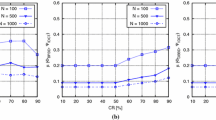Abstract
This paper presents the design concepts of wireless sensor network system constructed with autonomous sensing nodes, which operates at extremely low power levels. At first, conventional, wired civil structure health-monitoring system is reviewed. Then, the monitoring methodology is discussed focusing quantitative measurement accuracy. Issues of node synchronized sampling, multi-layer cluster, node distance and integrated sensor node module are discussed. Also, radio transceiver protocol candidates are reviewed from the point of connection to the Internet gateway. Sensor node consists of microprocessor, sensing analog front end, and radio transceiver. Last two factors are critical for power consumption. Therefore, low duty cycle measurement is essential, in order to accomplish the ultra low power level, which is equivalent to energy harvesting source, such as piezoelectric and solar cells, sensor node power management device circuit design is demonstrated for the high-spec measurement.













Similar content being viewed by others
References
Lynch, J. P., & Loh, K. J. (2006). A summary review of wireless sensors and sensor networks for structural health monitoring. The Shock and Vibration Digest, 38(2), 91–128.
Cho, S., Yun, C.-B., Lynch, J. P., Zimmerman, A. T., Spencer, B. F., & Nakagawa, T. (2008). Smart wireless sensor technology for structural health monitoring of civil structures. Steel Structures, 8, 267–275.
Lynch, J. P. (2007). An overview of wireless structural health monitoring for civil structures. Philosophical Transactions of the Royal Society A, 365, 345–372.
White Paper. (2010). A bridge health monitoring system based on NI hardware and software. Austin: National Instruments.
Sun, R.-J., Sun, Z., Dan, D.-H., & Sun, L.-M. (2006). An integrated FBG sensing system for bridge health monitoring. Proceedings of the SPIE, 6174, 61742Q1–61742Q7.
Kurata, N., Saruwatari, S., & Morikawa, H. (2006). Ubiquitous structural monitoring using wireless sensor networks. In Proceedings of the International Symposium on Intelligent Signal Processing and Communication Systems (pp. 99–102), 2006.
Suzuki, M., Saruwatari, S., Kurata, N., Minami, M., & Morikawa, H. High-fidelity synchronized sampling on wireless sensor networks for earthquake monitoring. In Technical Report of IEICE, Tokyo.
Sazonov, E., Janoyan, K., & Jha, R. (2004). Wireless intelligent sensor network for autonomous structural health monitoring. Proceedings of SPIE, 5384, 305–314.
NEC Corporation. (2008). ZigBee wireless module data sheet. Tokyo: NEC Corporation.
Arms, S. W., Townsend, C. P., Churchill, D. L., Galbreath, J. H., & Mundell, S. W. (2005). Power management for energy harvesting wireless sensors. In Proceedings of SPIE (pp. 1–9), San Diego, CA, 2005.
Matsuzawa, A. (2011). Energy efficient A/D converter design. In Proceedings of International Symposium on Low Power VLSI Design (pp. 59–83), Kyoko Japan, June 2011.
Murata Manufacturing Corporation. (2010). Piezo generator PAZ-09-0071-02. In Advanced Sustainable Technology Seminar, Tokyo: Murata Manufacturing Corporation.
Author information
Authors and Affiliations
Corresponding author
Rights and permissions
About this article
Cite this article
Hamasaki, T. Power management of autonomous wireless sensor node for structure health monitoring. Analog Integr Circ Sig Process 75, 217–224 (2013). https://doi.org/10.1007/s10470-012-9932-6
Received:
Revised:
Accepted:
Published:
Issue Date:
DOI: https://doi.org/10.1007/s10470-012-9932-6




